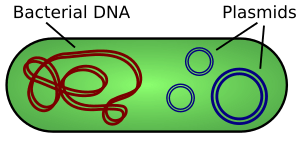Plasmid facts for kids
A plasmid is a tiny piece of DNA that is separate from a cell's main DNA. Think of it like a mini-chromosome! Plasmids can make copies of themselves all on their own.
The word plasmid was first used in 1952 by an American scientist named Joshua Lederberg. He studied molecular biology, which is about the tiny parts inside living things.
Plasmids are usually shaped like a circle and have two strands, just like a twisted ladder. You can find them naturally in bacteria. Sometimes, they are also found in other living things called eukaryotic organisms, like a type of yeast called Saccharomyces cerevisiae.
Plasmids are very small, ranging from 1 to over 1,000 kilobase pairs. A kilobase pair is a way to measure the length of DNA. A single cell can have anywhere from one to thousands of identical plasmids!
Plasmids are like tiny packages of genetic information that can move between cells. They can copy themselves inside a suitable host cell. Plasmids exist in all three main groups of life: Archaea, Bacteria, and Eukarya.
How Plasmids Move Around
Plasmids are not considered "alive" in the same way a cell is. They are just DNA. Unlike viruses, plasmids don't have a protective coat. They need help to move from one cell to another.
One way plasmids move is through a process called conjugation. This is when two bacteria connect and share DNA directly. Another way is through transformation. This happens when a cell takes in DNA from its surroundings.
Plasmids help bacteria share useful genes. This can give bacteria an advantage in their environment.
What Plasmids Do
Plasmids often carry special genes that help bacteria survive. For example, some plasmids can give bacteria resistance to antibiotics. This means the bacteria can survive even when antibiotics are present.
Other plasmids might help bacteria produce toxins. These toxins can help the bacteria compete with other microbes. Plasmids can also give bacteria the ability to use different food sources. For example, some plasmids help bacteria use nitrogen from the air or break down tough organic compounds. This can be very helpful when food is scarce.
Images for kids
-
An electron micrograph of a DNA fiber bundle, possibly a bacterial chromosome loop.
See also
 In Spanish: Plásmido para niños
In Spanish: Plásmido para niños




